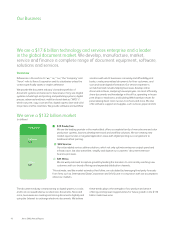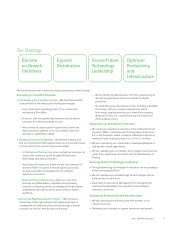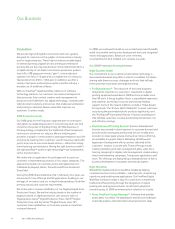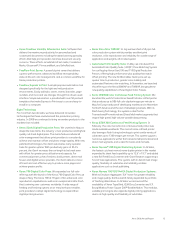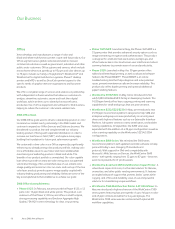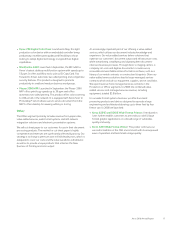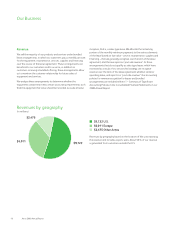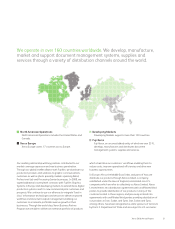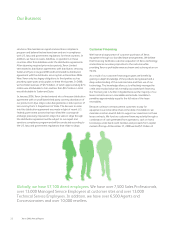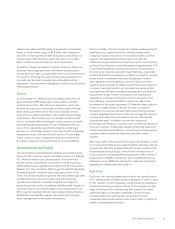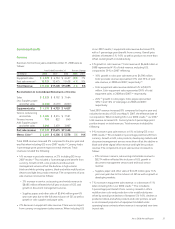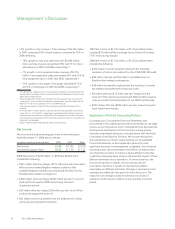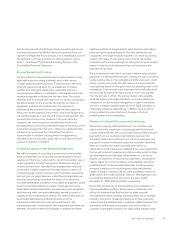Xerox 2008 Annual Report Download - page 22
Download and view the complete annual report
Please find page 22 of the 2008 Xerox annual report below. You can navigate through the pages in the report by either clicking on the pages listed below, or by using the keyword search tool below to find specific information within the annual report.
Our Business
Patents, Trademarks and Licenses
We are a technology company. Including our Xerox Palo Alto
Research Center (“PARC”) and XMPie subsidiaries, we were
awarded 609 U.S. utility patents in 2008. We were ranked 31st on
the list of companies that were awarded the most U.S. patents
during the year and would have been ranked about 27th with the
inclusion of PARC and XMPie patents. Including our research
partner Fuji Xerox Co., Ltd (“Fuji Xerox”), we were awarded over 940
U.S. utility patents in 2008. Our patent portfolio evolves as new
patents are awarded to us and as older patents expire. As of
December 31, 2008, we held approximately 8,900 design and
utility U.S. patents. These patents expire at various dates up to 20
years or more from their original filing dates. While we believe that
our portfolio of patents and applications has value, in general no
single patent is essential to our business or any individual segment.
In addition, any of our proprietary rights could be challenged,
invalidated, or circumvented or may not provide significant
competitive advantages.
In the U.S., we are party to numerous patent-licensing agreements
and, in a majority of them, we license or assign our patents to
others, in return for revenue and/or access to their patents. Most
patent licenses expire concurrently with the expiration of the last
patent identified in the license. In 2008, we added 11 agreements
to our portfolio of patent licensing agreements, and either we or
PARC was a licensor in all 11 of the agreements. We are also a
party to a number of cross-licensing agreements with companies
that hold substantial patent portfolios, including Canon, Microsoft,
IBM, Hewlett Packard, Océ, Sharp, Samsung and Seiko Epson.
These agreements vary in subject matter, scope, compensation,
significance and time.
In the U.S., we own approximately 570 trademarks, either
registered or applied for. These trademarks have a perpetual life,
subject to renewal every ten years. We vigorously enforce and
protect our trademarks.
Our brand is a valuable resource and continues to be ranked among the
top percentile of the most valuable global brands.
Competition
Although we encounter aggressive competition in all areas of our
business, we are the leader or among the leaders in each of our
principal business segments. Our competitors range from large
international companies to relatively small firms. We compete on
the basis of technology, performance, price, quality, reliability,
brand, distribution and customer service and support. To remain
competitive we invest in and develop new products and services
and continually improve our existing offerings. Our key competitors
include Canon, Ricoh, Hewlett-Packard, and, in certain areas of the
business, Pitney Bowes, Kodak, Océ, Konica-Minolta and Lexmark.
We believe that our brand recognition, reputation for document
knowledge and expertise, innovative technology, breadth of
product offerings, global distribution channels, customer
relationships and large customer base are important competitive
advantages. We and our competitors continue to develop and
market new and innovative products at competitive prices, and, at
any given time, we may set new market standards for quality,
speed and function.
Marketing and Distribution
We manage our business based on the principal business segments
described earlier. However, we have organized the marketing, selling
and distribution of our products and solutions according to
geography and channel type. We sell our products and solutions
directly to customers through our worldwide sales force and through
a network of independent agents, dealers, value-added resellers,
systems integrators and the Web. In the U.S. GIS continues to
expand its network of office technology suppliers to serve an ever-
expanding base of small and mid-size businesses. We utilize our
direct sales force to address our customers’ more advanced
technology, solutions and services requirements, and use cost-
effective indirect distribution channels for basic product offerings.
In large enterprises, we follow a services-led approach that enables
us to address two basic challenges facing large enterprises:
• How to optimize infrastructure to be both cost effective and
globally consistent.
• How to improve the value proposition and communication with
their customers.
In response to these needs, we offer a go-to-market approach that
leads with the largest direct sales and service delivery force in the
industry available on a globally consistent manner. This can range
from hardware, software or services in whatever combination is
necessary to meet the needs of that customer.
We market our Phaser line of color and monochrome laser-class
and solid ink printers primarily through office information
technology resellers, who typically access our products through
distributors. We continue to expand our distribution partnerships in
North America through additional information technology resellers
and by enhancing our network of independent agents. We also
continued to increase product offerings available through a
two-tiered distribution model in Europe and developing markets.
20 Xerox 2008 Annual Report
�
�
�
�


